There is one thing that the biggest apps have in common—that is a web-to-app funnel. It opens up a brand new audience for your UA campaigns and allows you to skirt fees associated with Apple and Google.—Steve P. Young, founder at App Masters
FunnelFox CEO, Andrey Shakhtin, joined Steve’s webinar on revenue growth through web-to-app funnels as a guest expert. He explained how to launch, optimize, and analyze web funnels to increase revenue and what benchmarks to target. In this article, we’ve summarized the key points from the webinar. For deeper insights, feel free to watch the recording—you’ll find it under the FAQ section.
Web-to-app funnel launch roadmap
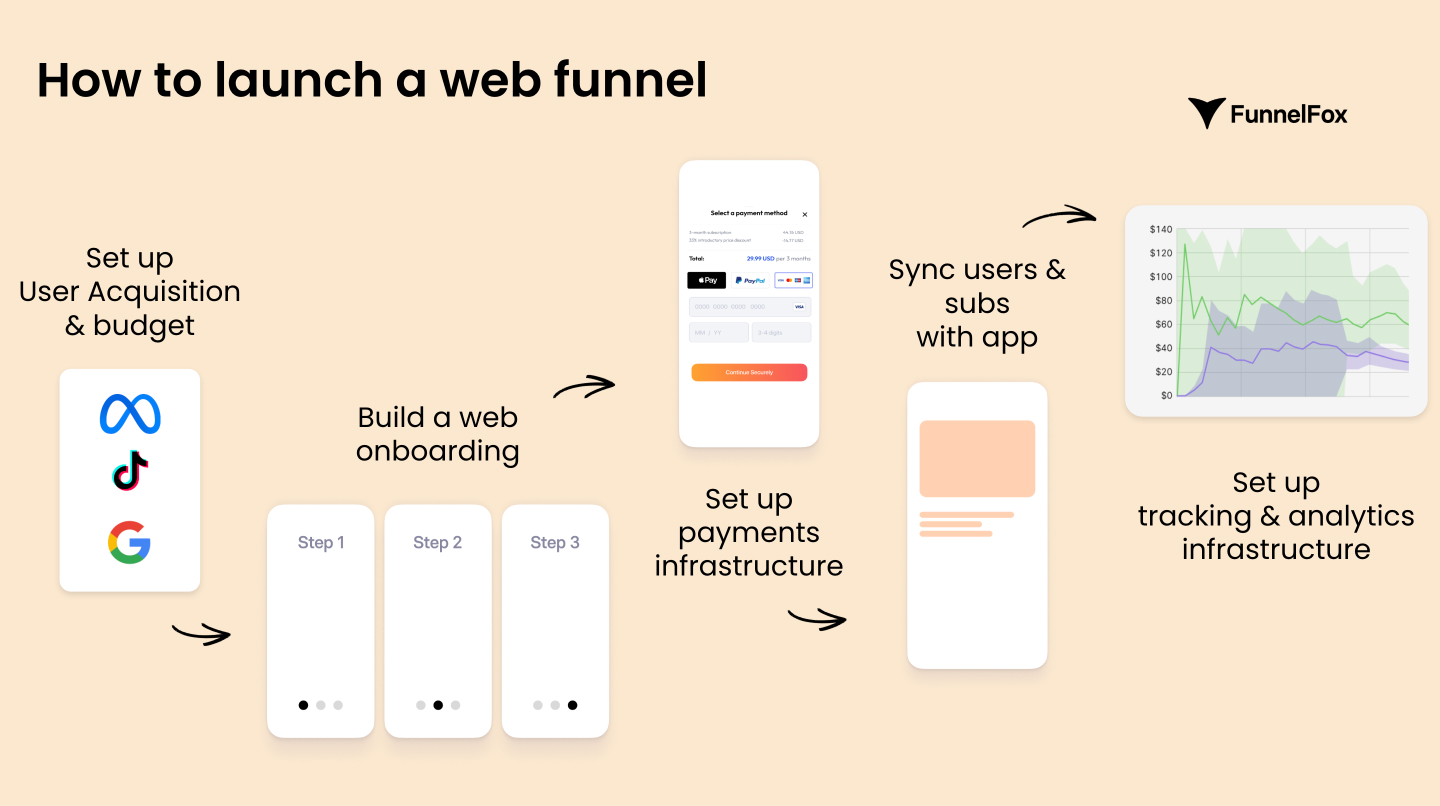
Step 1. Set up your user acquisition and allocate a budget
To make your funnel work, you need to allocate time and budget to optimize it and experiment. For user acquisition, start with the same advertising networks you already use for your app, like Meta, TikTok, and Google.
💡 Andrey suggests starting with Meta—it’s the easiest to begin with, offers more predictable outcomes, and its creatives perform well.
Step 2. Build a web onboarding
Web onboarding is a sequence of web pages that function like mobile app screens. It can mirror your app’s onboarding flow or be tailored to specific segments of your audience. Its main goal is to engage people with elements like quizzes and convince them to try your product.
💡 On the web, you don’t have names like Apple and Google behind you as in app stores. So, when designing your onboarding, make sure it helps you build trust.
- Use trust-building elements at the start of onboarding (e.g., number of your users, reviews, mentions on reputable resources)
- Provide personalized feedback based on user inputs
- Showcase expected results and value (e.g., predicted weight loss timelines)
- Align personalized offers with expected results
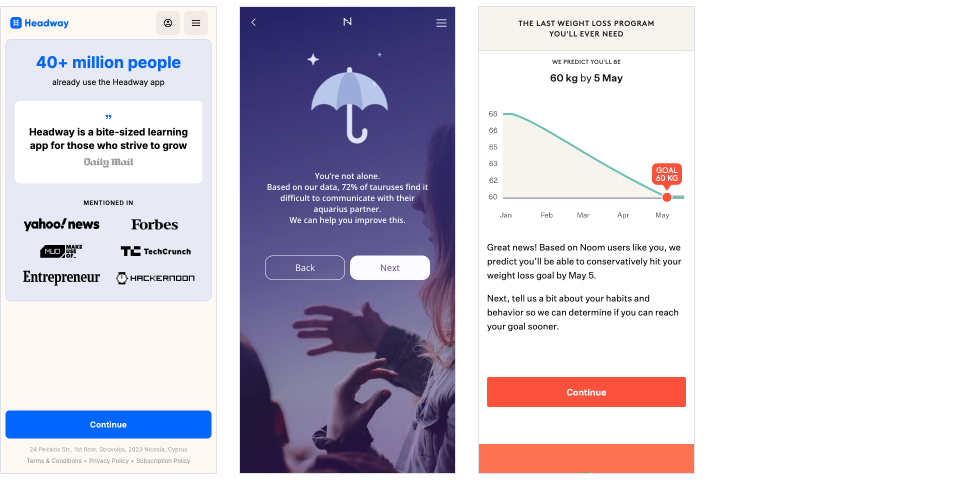
Step 3. Set up payment infrastructure
If you’re going to bypass app stores’ commissions and increase app revenue by selling subscriptions on the web, you must approach your payment infrastructure seriously. Make sure the payment flow is as smooth as possible and doesn’t have any hiccups or obstacles for users.
💡 Pro tip: With FunnelFox Billing, you can set up smart payment routing, automate recurring billing, and manage refunds and chargebacks across all providers—no code or heavy integrations required.
All your payment flows, revenue recovery, and dispute prevention are handled in one dashboard, so you can launch and scale your funnel faster.
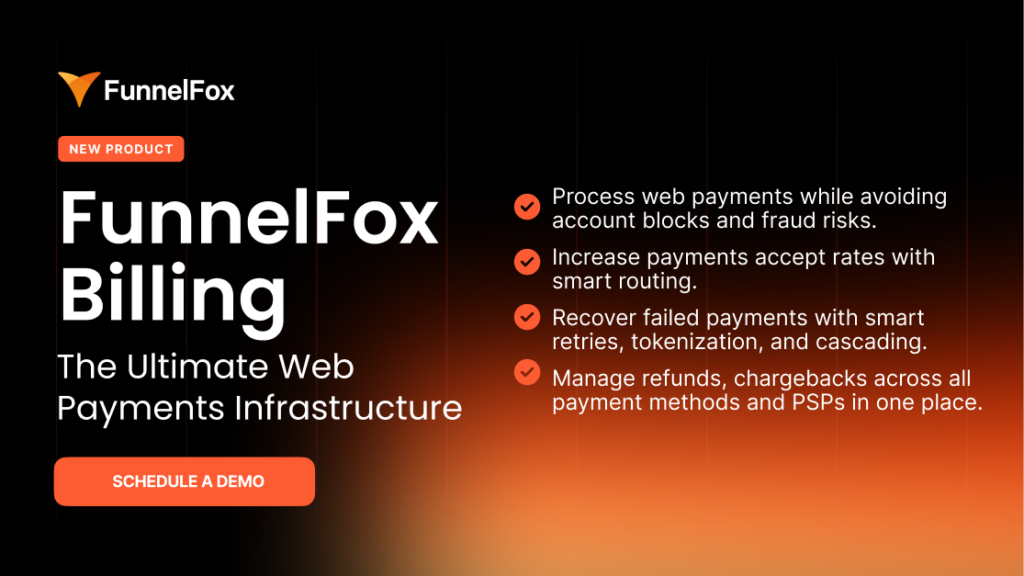
Step 4. Sync users and subscriptions with your app
After purchase, you need to sync new users who purchased subscriptions on the web with your app. It’s an important step as poor syncing can lead to duplicate charges, support issues, and ultimately user churn. Make sure you capture key data points—like subscription status, expiration dates, and trial periods. If you don’t have an in-house solution for that, consider services like Adapty.
Step 5. Set up analytics
The beauty of web-to-app funnels is that you have 100% attribution and zero IDFA restrictions.
Meta reports that only 15% of the audience overlaps between app and web campaigns. Web-to-app funnels let you reach a largely untapped audience you wouldn’t normally get with app install or trial acquisition campaigns. To make the most of this opportunity, you’ll need solid marketing tracking and analytics tools to measure, grow, and optimize your funnel performance.
How to optimize web-to-app funnels to increase revenue faster: proven tips
Don’t expect your funnel to drive mind-blowing results from day one—you still have to optimize it.
Optimize your user acquisition
User acquisition is the most important thing that impacts your funnel performance and revenue growth. You can have a beautiful, polished onboarding or payment flow, but if you don’t attract the right audience, it just won’t work out. The audience quality depends heavily on the creatives and channels you use.
❓Do static images perform better than videos?
It depends on the product and its audience—for weight loss apps, static creatives work better, and fitness apps get better results with videos and UGC.
The channel also affects your choice. Platforms like Instagram offer multiple content formats—such as the standard feed and reels, and each requires a different creative approach.
If you’re launching your first funnel and don’t have any creatives for the web yet, start with your top-performing creatives from your app campaigns. You can also check your competitors’ web-to-app funnels if they run any. With various creatives on hand, you can experiment and identify what works best for you.
Speaking of the channels, web funnels open up access to additional inventory like Google Search Ads, Discovery Network, Display Network, or affiliate networks.
Ensure seamless payment flow
While many start with onboarding quiz optimization, it’s more effective to focus on payment flow after user acquisition, as it directly affects revenue growth. You can experiment with different subscription plans, including various trial options and pricing strategies.
Funnel optimization is about finding the perfect balance between your audience, user acquisition strategy, storytelling in web onboarding, and monetization.
Remember that different segments require different approaches. For example, for global subscriptions offering local currencies can increase the conversion rates by 20-30%.
Consider introducing upsells
Upsells can work wonders, especially with complementary products. A fitness app selling a personalized fitness plan might upsell a meal plan as nutrition complements fitness goals. Or, it can offer multiple upsells—let’s say, an anti-stress course or nutritional supplements alongside the main product. Many successful funnels implement multiple upsells (2-3) in sequence to improve LTV and ROAS and ultimately increase revenue.
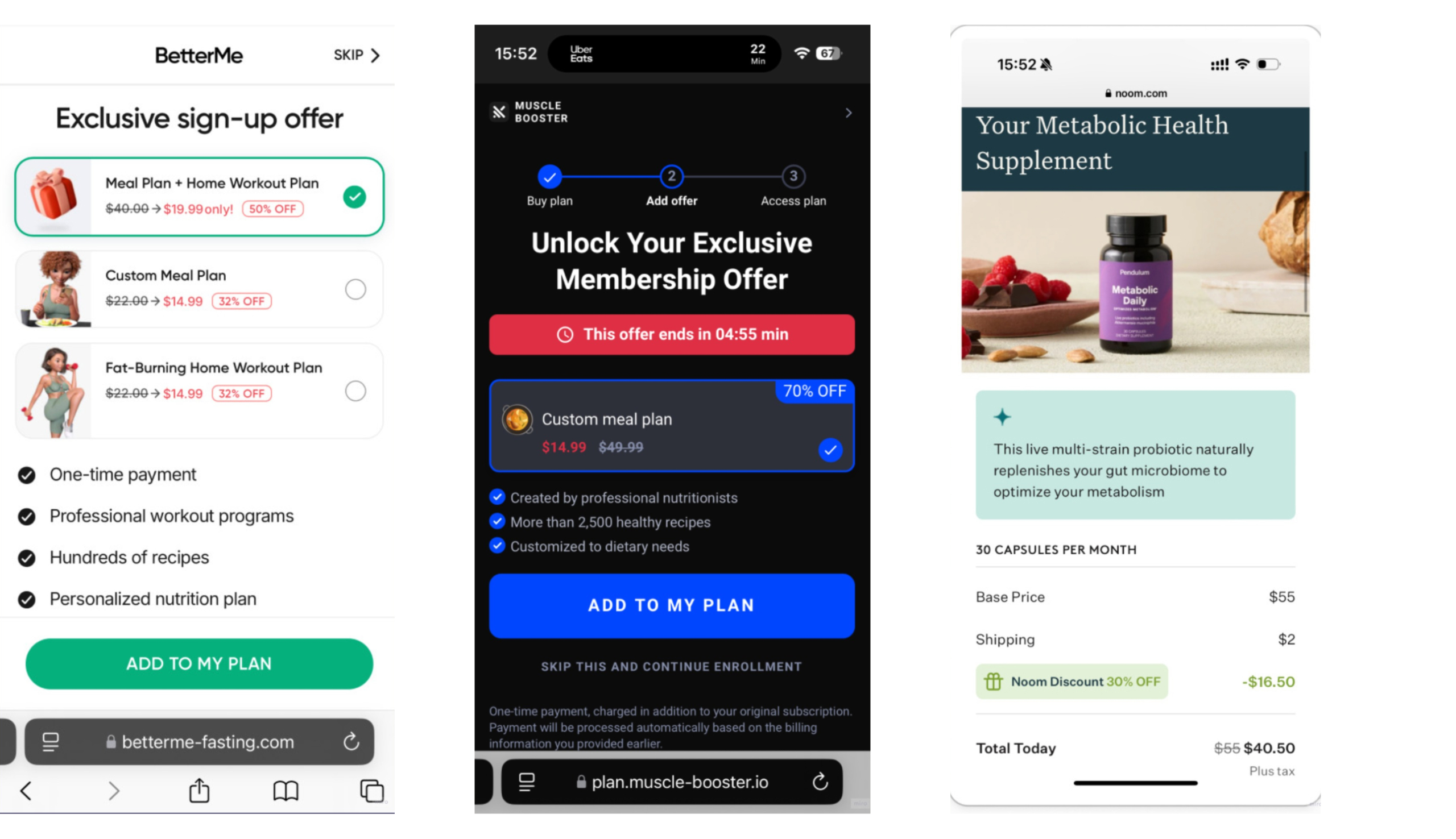
Experiment with different subscription models and trial strategies
Regarding subscription configurations, there are two successful approaches: three-plan structure and paid trial configuration.
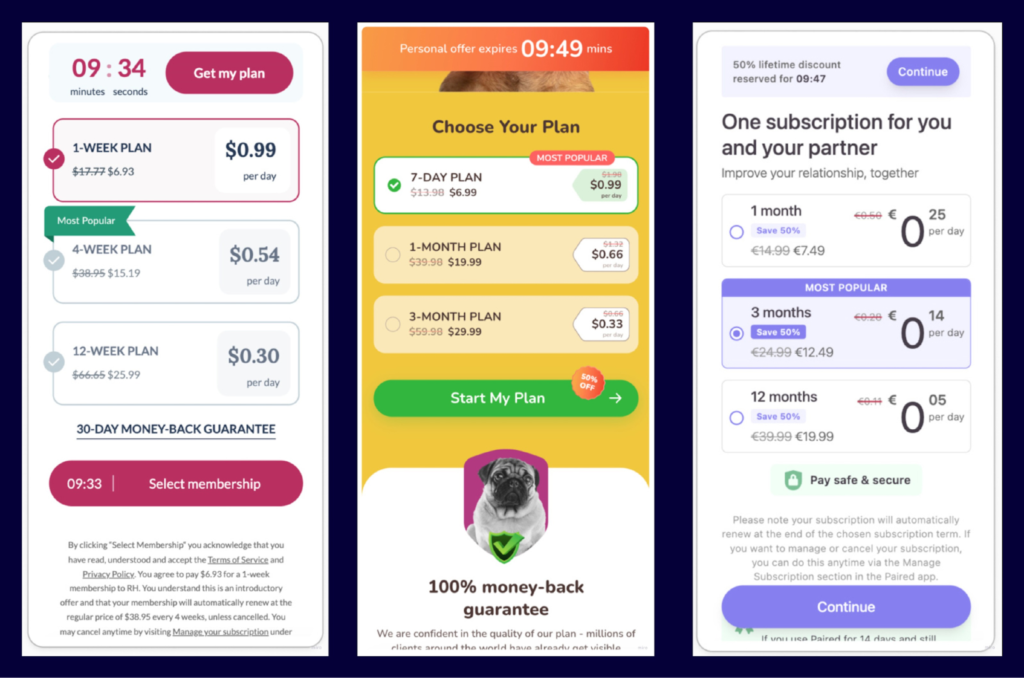
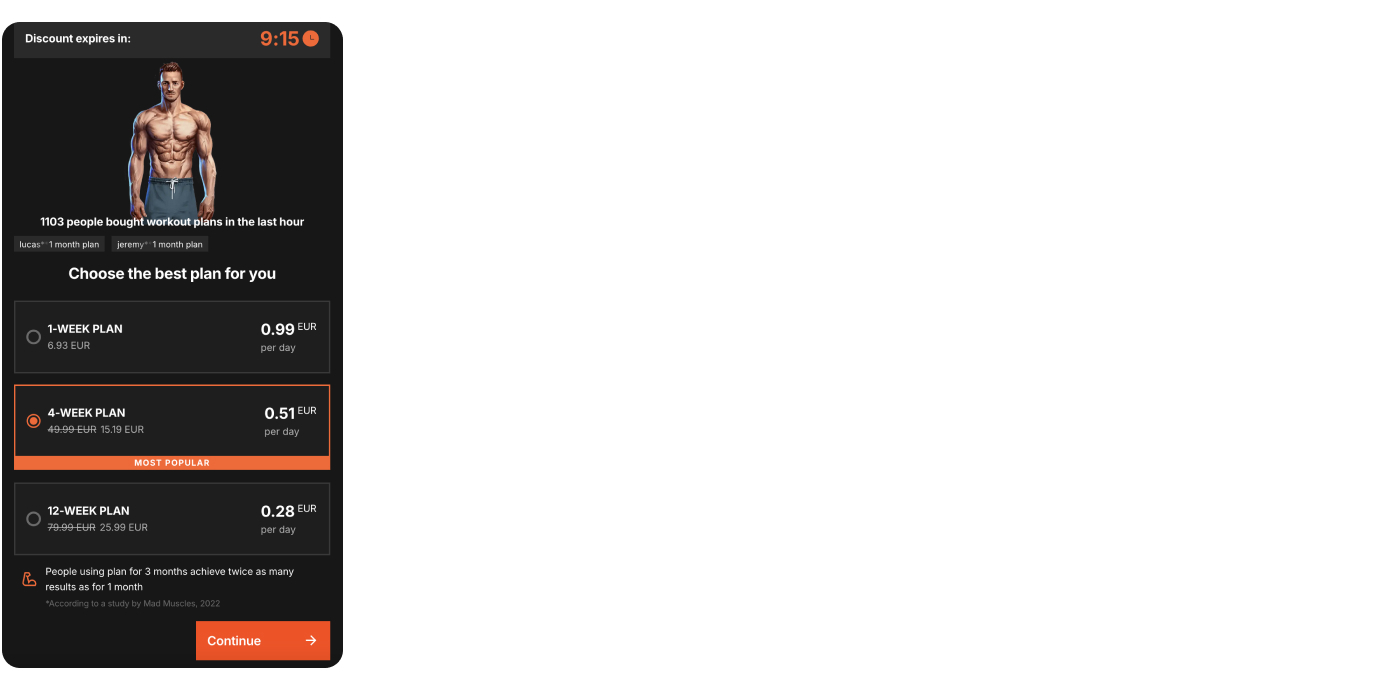
Free trials have become less effective, especially for paid acquisition. While they work well for organic traffic where users have higher motivation, paid acquisition often attracts users less inclined to convert after the trial ends. This leads to issues like insufficient funds and failed payments.
One interesting pricing approach is being transparent about trial costs. For example, showing users what it costs the company to offer a 14-day trial and letting them choose between different trial prices (€1, €11, €16.41). This approach helps anchor the value and explains costs to users while supporting those who need lower-priced options.

Web-to-app funnel metrics & their analysis
Web funnels typically experience a 50% drop-off at the welcome screen, with about 20% reaching the payment page and 1-5% completing a purchase. Conversion rates can vary based on audience, pricing, and creative quality.
Let’s compare app and web funnels metrics. These are the average numbers based on various projects:
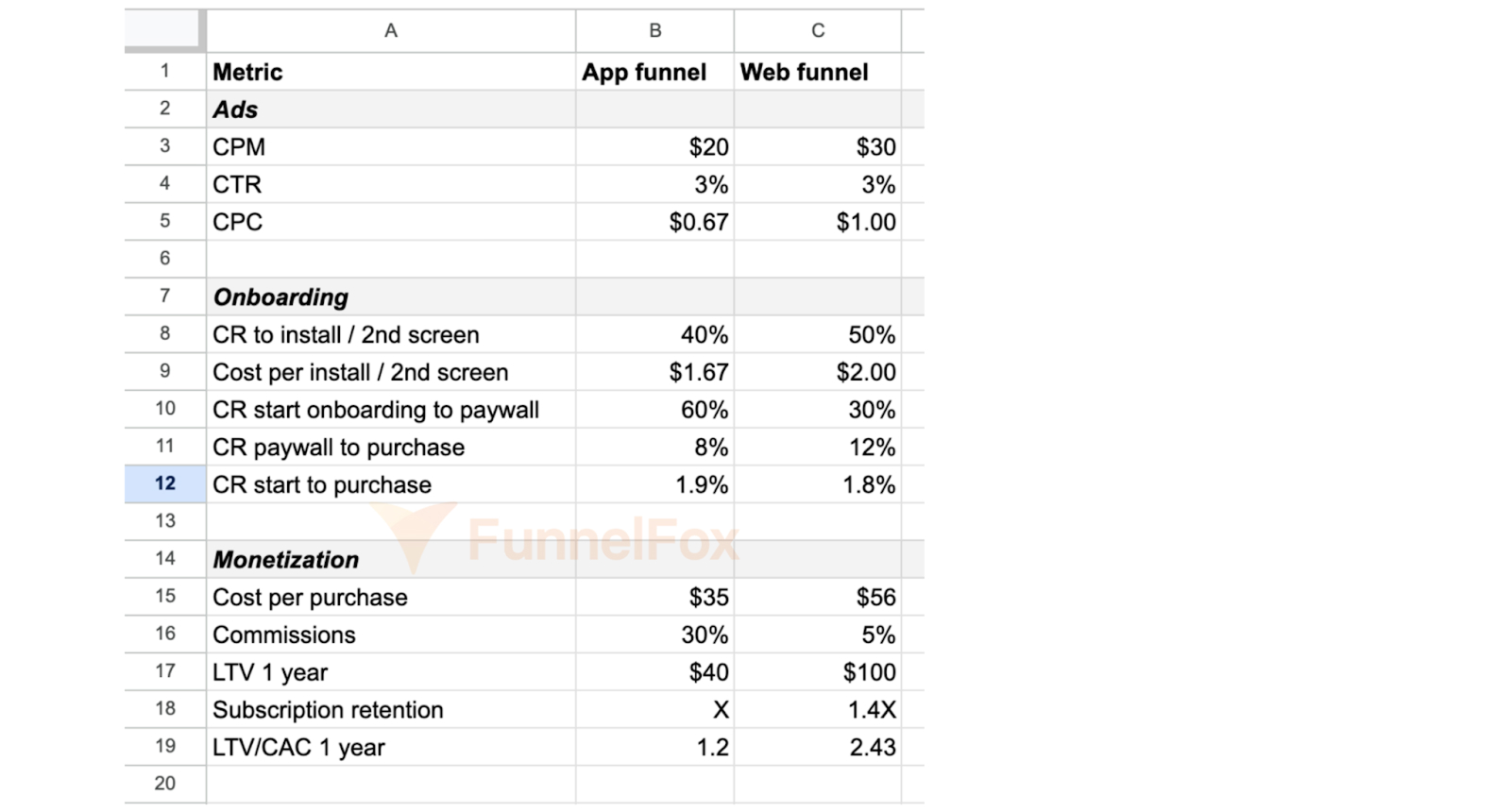
While the app funnel is cheaper to launch and drives better onboarding conversions, it comes with higher commissions and lower LTV.
Web-to-app funnels provide higher LTV due to flexible monetization strategies and higher subscription retention. This can lead to double the ROI compared to app funnels.
💡 You can go with more aggressive pricing strategies on the web as users are generally used to paying higher prices on websites compared to apps (for example, Amazon orders often run into hundreds of dollars).
Build effective web-to-app funnels in no time & without developers with FunnelFox
Building fully functional web-to-app funnels is a daunting task. With FunnelFox, you can launch, optimize, and experiment with your web-to-app conversion flows in just one hour—even with a single growth manager on your team.
Our platform removes the traditional complexity and technical barriers, letting you focus on what matters most—growing your mobile app business. Each pre-built component comes as a ready-to-test hypothesis, backed by proven conversion strategies, so you can start improving your metrics right away.
Whether you’re just starting out or looking to scale your existing app, FunnelFox provides all the tools and insights you need to create high-converting web-to-app funnels that drive sustainable growth.










